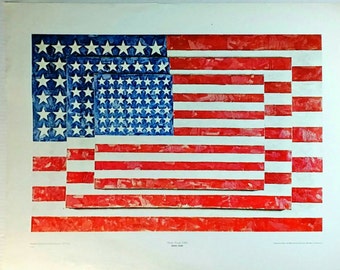
These include Carroll Dunham on dreams, Ruth Fine on monotypes and working proofs, Michio Hayashi on Japan, Terrance Hayes on flags, and Colm Toíbín on nightmares, among many others.
3 FLAGS JASPER JOHNS SERIES
Inspired by the artist’s long-standing fascination with mirroring and doubles, this book provides an original and exciting perspective on Johns’s work and its continued relevance.Ī diverse group of curators, academics, artists, and writers offer a series of essays-including many paired texts-that consider aspects of the artist’s work, such as recurring motifs, explorations of place, and use of a wide array of media. Over the past sixty-five years, he has produced a radical and varied body of work marked by constant reinvention. 1930) is arguably the most influential artist living today. New York magazine is the exclusive media sponsor. The opening dinner is sponsored by Christie’s This exhibition is supported by an indemnity from the Federal Council on the Arts and the Humanities. Margulies, the National Endowment for the Arts, Monique and Gregg Seibert, Norman Selby and Melissa Vail Selby, and Gloria H. Heyman, Sheila and Bill Lambert, Barbara and Richard Lane, Margo Leavin, Janie C. Gael Neeson Foundation.Īdditional support is provided by Aaron and Leslee Cowen, Kathy and Richard Fuld, Johanna and Leslie Garfield, Ashley Leeds and Christopher Harland, Mrs. Rosen, The Robert Lehman Foundation, and Stefan T. Caplan, Marguerite Steed Hoffman and Tom Lentz, the Jon and Mary Shirley Foundation, Sueyun and Gene Locks, Susan and Larry Marx, Marsha and Jeffrey Perelman, Donna Perret Rosen and Benjamin M.

Significant support is provided by Constance R. Major support is provided by the Barbara Haskell American Fellows Legacy Fund The Brown Foundation, Inc., of Houston Nancy and Steve Crown Anne and Joel Ehrenkranz Ellsworth Kelly Foundation and Jack Shear Agnes Gund Kristen and Alexander Klabin Helen and Charles Schwab the Whitney’s National Committee and an anonymous donor. Bluhm Matthew Marks and Kevin and Rosemary McNeely, Manitou Fund. Generous support is provided by Judy Hart Angelo Neil G. In New York, this exhibition is sponsored by Jasper Johns: Mind/Mirror is presented by Jasper Johns: Mind/Mirror is organized by the Whitney Museum of American Art and the Philadelphia Museum of Art. Vogelman, Exhibition Assistant, in Philadelphia, and Lauren Young, Curatorial Assistant, in New York. and Katherine Sachs Senior Curator of Contemporary Art, Philadelphia Museum of Art, and Scott Rothkopf, Senior Deputy Director and Nancy and Steve Crown Family Chief Curator, Whitney Museum of American Art, New York, with Sarah B. The organizing curators are Carlos Basualdo, Keith L. This exhibition is organized by the Whitney Museum of American Art and the Philadelphia Museum of Art. Taken together, they provide an immersive exploration of the many phases, treasures, and mysteries of a radical, enduring, and still-evolving career. Individually, each gallery focuses on a particular aspect of Johns’s thought and work through the lens of different themes, processes, images, mediums, and even emotional states. Organized in largely chronological order, the retrospective presents pairs of related galleries-one in each city-that offer varied perspectives on the artist’s turns of mind. This unique dual structure draws on the artist’s lifelong fascination with mirroring and doubles, so that each half of the exhibition echoes and reflects the other.

Conceived as a whole but displayed in two distinct parts, the exhibition appears simultaneously here at the Whitney and at the Philadelphia Museum of Art, two institutions with which Johns has had long-standing relationships. Featuring his most iconic works along with many others shown for the first time, it comprises a broad range of paintings, drawings, prints, and sculptures from 1954 to today across two sites. Jasper Johns: Mind/Mirror is the most comprehensive retrospective ever devoted to Johns’s art.

His profoundly generative practice helped spark movements including Pop art, Minimalism, and Conceptualism, among others, and has inspired successive generations of artists to this day. Johns’s early use of common objects and motifs, language, and inventive materials and formats upended conventional notions of what an artwork is and can be. He was born in 1930 in Augusta, Georgia spent the majority of his adult life in New York and today lives in Sharon, Connecticut, where, at the age of ninety-one, he remains active in his studio. Jasper Johns’s groundbreaking work sent shock waves through the art world when it was first shown in the late 1950s, and he has continued to challenge new audiences-and himself-over a career spanning more than sixty-five years.


 0 kommentar(er)
0 kommentar(er)
